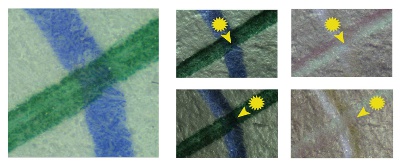Acquisition
Three methods for recording light scattering microscopic images have been developed. They include: special illumination techniques to record a series of images where the direction of lighting changes in the prearranged sequence; orthogonal illuminator for the on-line analysis of shadow and gloss of stroke; and a dark field operating monochromatic, coherent light source, which was designed to emphasize the contrast at the borders of text objects.
Image processing
For the on-line and off-line processing of sequential images two algorithms have been implemented, which enable analysis of the shadow relief and gloss of ink or toner. Application of the unique procedure of the chrominance normalization facilitates the analysis of the colored shadow reliefs. In the examined image crossing strokes of writing are seen only as shadow relief without the original coloring resulting from dye or pigment. Through the spatial segmentation of writing line traces and the enhancement of dynamics based on gradient approach, unambiguous imaging of ink gloss have been achieved.
Analysis and visualization
Visualization of the sequence of images presenting crossing writing lines acquired under directional lighting was applied for the analysis of writing pressure indentions continuity. Images obtained in monochromatic, dark field illumination are used to examine the local changes in light scattering. Based on the document surface examination, the forensic expert can determine the chronology of the writing strokes.



